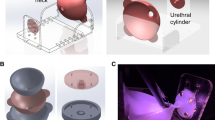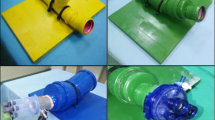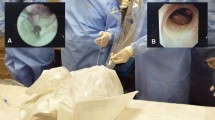Abstract
A training model is usually needed to teach robotic surgical technique successfully. In this way, an ideal training model should mimic as much as possible the “in vivo” procedure and allow several consecutive surgical simulations. The goal of this study was to create a “wet lab” model suitable for RARP training programs, providing the simulation of the posterior fascial reconstruction. The second aim was to compare the original “Venezuelan” chicken model described by Sotelo to our training model. Our training model consists of performing an anastomosis, reproducing the surgical procedure in “vivo” as in RARP, between proventriculus and the proximal portion of the esophagus. A posterior fascial reconstruction simulating Rocco’s stitch is performed between the tissues located under the posterior surface of the esophagus and the tissue represented by the serosa of the proventriculus. From 2014 to 2015, during 6 different full-immersion training courses, thirty-four surgeons performed the urethrovesical anastomosis using our model and the Sotelo’s one. After the training period, each surgeon was asked to fill out a non-validated questionnaire to perform an evaluation of the differences between the two training models. Our model was judged the best model, in terms of similarity with urethral tissue and similarity with the anatomic unit urethra-pelvic wall. Our training model as reported by all trainees is easily reproducible and anatomically comparable with the urethrovesical anastomosis as performed during radical prostatectomy in humans. It is suitable for performing posterior fascial reconstruction reported by Rocco. In this context, our surgical training model could be routinely proposed in all robotic training courses to develop specific expertise in urethrovesical anastomosis with the reproducibility of the Rocco stitch.



Similar content being viewed by others
References
Sotelo RJ, Astigueta JC, Carmona et al (2009) Chicken gizzard as a new model for laparoscopic urethrovesical anastomosis training. Acta Urol Espagnol 33:1083–1087
Yang RM, Bellman GC (2006) Laparoscopic urethrovesical anastomosis: a model to assess surgical competency. J Endourol 20:679–682
Sanchez C, Kikanov V (2000) Chicken as the experimental model for practicing of the urethro-vesical anastomosis during laparoscopic radical prostatectomy. Eur Urol 3:777–780
Nadu A, Olsson LE, Abbou CC (2003) Simple model for training in the laparoscopic vesicourethral running anastomosis. J Endourol 17:481–484
Laguna MP, Arce-Alcazar A, Mochtar CA et al (2006) Construct validity of the chicken model in the simulation of laparoscopic radical prostatectomy suture. J Endourol 20:69–73
Jiang C, Lin T, Zhang C et al (2008) A training model for laparoscopic urethrovesical anastomosis. J Endourol 22:1541–1545
Rocco F, Gadda F, Acquati P et al (2001) Personal research: reconstruction of the urethral striated sphincter. Arch Ital Urol Androl 73:127–137
Katz R, Hoznek A, Antiphon P, Velthoven Van et al (2003) Cadaveric versus porcine models in urological laparoscopic training. Urol Int 71:310–315
Van Velthoven RF, Hoffmann P (2006) Methods for laparoscopic training using animal models. Curr Urol Rep 7:114–119
Patel VR, Coelho RF, Palmer KJ, Rocco B (2009) Periurethral suspension stitch during robot-assisted laparoscopic radical prostatectomy: description of the technique and continence outcomes. Eur Urol 56(3):472–478
Author information
Authors and Affiliations
Corresponding author
Ethics declarations
Conflict of interest
The authors declared no potential conflicts of interest with respect to the research, authorship, and/or publication of this article.
Research involving human participants and/or animals
This paper does not contain any studies with human participants performed by any of the authors; all procedures performed in studies involving animals were in accordance with the ethical standards of the institution or practice at which the studies were conducted.
Informed consent
Informed consent was obtained from all individual participants included in the study.
Rights and permissions
About this article
Cite this article
Cacciamani, G., De Marco, V., Siracusano, S. et al. A new training model for robot-assisted urethrovesical anastomosis and posterior muscle-fascial reconstruction: the Verona training technique. J Robotic Surg 11, 123–128 (2017). https://doi.org/10.1007/s11701-016-0626-4
Received:
Accepted:
Published:
Issue Date:
DOI: https://doi.org/10.1007/s11701-016-0626-4




